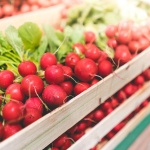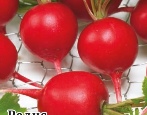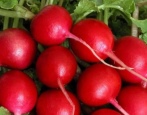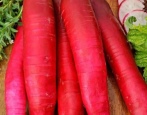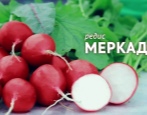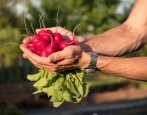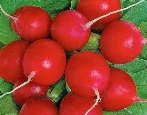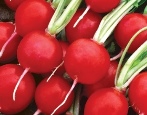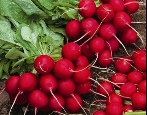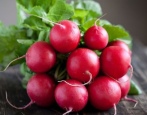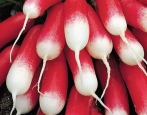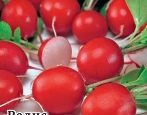
- Year of approval: 2007
- Ripening terms: mid-season
- Leaf rosette shape: semi-upright
- Leaves: obovate, yellowish green
- Petiole: with a slight anthocyanin coloration
- The form: rounded
- Coloration: Red
- Weight, g: 10-12
- Color of the pulp: white
- Pulp (consistency): tender, juicy
The first early vitamin vegetable that appears in the diet of every person is radish. The most useful will be a root crop grown in the garden. Among the unpretentious and productive varieties that can be grown in almost any climatic conditions is the mid-season Saksa RS variety.
Breeding history
The Sachs RS radish was obtained thanks to the work of domestic breeders of the research and production company "Russian seeds" in 2005. After two years of variety trials (in 2007), the vegetable crop was added to the State Register of approved for use. You can grow a vegetable on a garden ridge, and under a film, and in a greenhouse structure. The variety is popular and is massively cultivated in different regions of Russia, as it quickly adapts to climatic conditions.
Description of the variety
Radish is a plant with a neat semi-erect rosette of leaves, the height of which does not exceed 22-25 cm. The foliage of the plant is medium-sized, obovate with a smooth surface. The color of the foliage is yellowish-green, and the petioles are characterized by a weak anthocyanin coloration. Each rosette consists of 5-6 leaves. A distinctive feature of the plant is a slightly raised rosette of stems with leaves.
Characteristics of the appearance of the plant and root crops
The variety belongs to small-fruited varieties. Fruits of the same shape and size ripen. The average weight of a vegetable is 10-12 grams. The tubers do not exceed 3-3.5 cm in diameter. The shape of the root crops is round with a flat head or spherical. Ripe radish is evenly covered with a red or red-raspberry cover. The vegetable skin is thin, tender, absolutely smooth, with a noticeable shine.
The harvested tubers can be transported over long distances, as well as stored for a long time, if the storage conditions are observed. During keeping quality, vegetables do not flabby, voids do not form in the pulp, taste is not lost.
Purpose and taste of tubers
The radish has a pleasant taste. The snow-white pulp is characterized by a dense, fleshy, tender, crispy and juicy structure without voids, fibrous and watery. The taste is dominated by a slight sweetness, complemented by a barely noticeable spike and a pleasant aroma. The peel of the vegetable is not bitter. It is also worth noting the high content of vitamins in the pulp.
Harvested root vegetables can be eaten fresh, added to various vegetable salads, and used as a decoration for cold dishes.
Maturation
Saksa RS represents a group of mid-season varieties. From the moment the first shoots appear until the tubers are fully ripe, it takes 20-25 days. Ripening of the culture is friendly, so the harvest can be harvested in 1-2 stages.
Yield
The yield of the variety is excellent. If you take proper care of the radish, then you can count on a decent harvest - about 4 kg of juicy vegetable from 1 m2 of plantings. In some cases, it is possible to select only 0.8-1.3 kg / m2.
Growing and care
The vegetable is cultivated through direct sowing of seeds. Landing is carried out from late May to mid-July. In the prepared area, long grooves are made with a depth of 1-1.5 cm, where radish seeds are sown.The distance between the rows does not exceed 10-12 cm. Sowing is carried out according to the scheme 10-12x5 cm. After planting, abundant watering of the beds is required. Radishes are usually planted at a temperature of + 18-20 degrees. Do not plant radishes in an area where cruciferous plants used to grow.
Vegetable agricultural technology includes simple standard procedures:
- daily watering with settled water (if the dry period);
- fertilization (several times per season);
- weeding and loosening of the soil;
- thinning as needed, keeping the distance between plantings 5-6 cm;
- prevention of viruses and insect infestations.
This variety can be grown even at home - in boxes or containers, observing basic agricultural techniques.
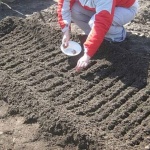

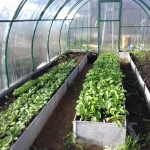
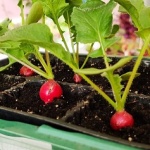
Soil requirements
Vegetable crops prefer loose, light, nutritious and breathable soils with low or neutral acidity. The culture develops and bears fruit well in fluffy loamy and sandy loam soils. It is not recommended to plant the vegetable in heavy and waterlogged substrates.
Required climatic conditions
Radish Sachs RS is an incredibly thermophilic plant, so the site should be allocated for planting bright and sunny. Due to its increased sensitivity to light, it is better if the plant receives light for 10-12 hours. A characteristic feature of the plant is good stress resistance, due to which the vegetable easily tolerates temperature fluctuations and short drought.
Disease and pest resistance
Vegetable immunity is average. Saxa RS is tolerant of powdery mildew. During the growing season, the culture is often attacked by pests - red-colored midges and cabbage flies. Along with this, the vegetable is resistant to cracking and blooming.

